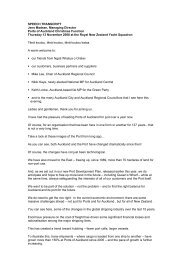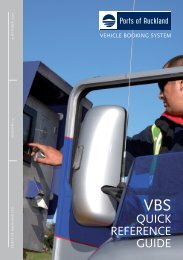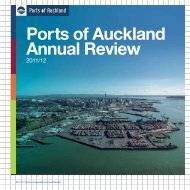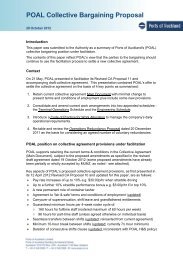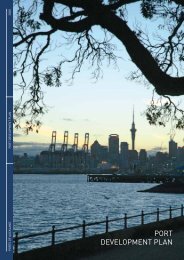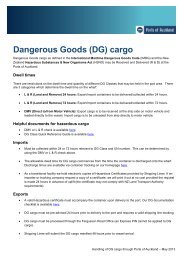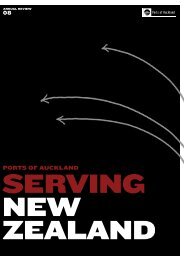ONE - Ports of Auckland
ONE - Ports of Auckland
ONE - Ports of Auckland
Create successful ePaper yourself
Turn your PDF publications into a flip-book with our unique Google optimized e-Paper software.
The result was largely due to some<br />
shipping service changes – including the<br />
consolidation <strong>of</strong> the North Asia service<br />
by Hamburg Sud, COSCo, MOL and NyK<br />
which based its import call on POAL from<br />
July 2009. That decision was a pleasing<br />
confirmation <strong>of</strong> the lines’ faith in POAL as<br />
an optimal NZ location for import cargo.<br />
Our Christmas peak volumes were also<br />
much higher than expected by our<br />
customers and ourselves. while all <strong>of</strong> us<br />
anticipated a short, sharp peak, we were<br />
surprised by a bow wave <strong>of</strong> volume that<br />
continued to surge through a much longer<br />
than expected Christmas/New year peak<br />
season.<br />
MARKET JITTERS<br />
despite that, the market remained jittery in<br />
the face <strong>of</strong> continued uncertainty around the<br />
longevity and sustainability <strong>of</strong> the volume.<br />
The consolidation <strong>of</strong> shipping lines leading<br />
to fewer services, reduced vessel numbers<br />
but larger ships, brought larger and ‘lumpier’<br />
exchanges. both the lines and POAL have<br />
struggled with schedule integrity. At POAL<br />
we’ve suffered the effects <strong>of</strong> the delays our<br />
customers have experienced in Asia. Add<br />
to that the increased use <strong>of</strong> slow steaming<br />
for lines to save fuel costs, and we see a<br />
picture <strong>of</strong> difficult instability in schedules all<br />
<strong>of</strong> which puts greater pressure on the port<br />
operation.<br />
For our part that uncertainty made us<br />
cautious – perhaps overly so. It was difficult<br />
to achieve a balance since there was<br />
volatility in volume from week to week and<br />
month to month. In the final analysis it<br />
meant that operationally we were stretched.<br />
we recognise the need to build more<br />
flexibility into our labour model and plant<br />
availability to cater for the inevitable vessel<br />
delays, increased exchanges and one-<strong>of</strong>f<br />
events such as vessel swaps or extra-loaders.<br />
Right now we are putting mechanisms in<br />
place which we are confident will enable us<br />
to deliver a more consistent performance<br />
moving forward.<br />
CUSTOMER COLLAbORATION<br />
This is however, a major challenge since<br />
the market these days in our container<br />
terminal business remains volatile. what we<br />
are now hoping for, is increasing stability in<br />
the market – a little more certainty around<br />
forecast volume and better schedule<br />
integrity. Reports indicate continued volume<br />
growth in the market. However, we have to<br />
set that against some capacity reduction<br />
particularly southbound. with the imminent<br />
approach <strong>of</strong> the peak season, that is likely<br />
to mean the introduction <strong>of</strong> extra loaders by<br />
some lines to cater for additional volume.<br />
They in turn, can once again exacerbate the<br />
‘lumpy’ exchange problem we had last year.<br />
we recognise that in such a volatile<br />
market our customers need a higher level<br />
<strong>of</strong> flexibility in our service response. but<br />
planning is key to the efficiency <strong>of</strong> our<br />
service delivery and to properly plan we<br />
need information and as early as possible!<br />
To make sure we get that information we are<br />
determined to continue to engage closely<br />
with our customers to get a clear grasp <strong>of</strong><br />
their business and cargo flows so that we<br />
can prepare to the best <strong>of</strong> our ability, to<br />
service those exchanges efficiently.<br />
On the flip side, we hope too that in this<br />
closer working relationship, our customers<br />
come to understand that an efficient<br />
POAL operation and service hinges largely<br />
on interaction with our customers and<br />
especially on, information received from<br />
them.<br />
Alongside our new web product<br />
developments like InterACT and changes<br />
to our business processes, we have also<br />
established business reference groups<br />
which enable us to lift the level <strong>of</strong><br />
collaboration with all stake holders in the<br />
Supply Chain. This continues to be a key<br />
focus for us<br />
Information is a very important part <strong>of</strong> an<br />
efficient Supply Chain. It is a well known<br />
principle that when people have the<br />
information they need, they can do the job<br />
better – and if everyone in the chain does<br />
their part correctly, the whole process<br />
comes together.<br />
03




